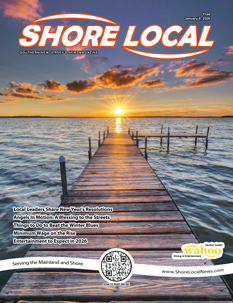The five causes of ‘sunny day flooding’
By Meteorologist Joe Martucci
Every time there’s “sunny day flooding,” many ask how there can be coastal flooding, when there’s no rain.
There are five ingredients to coastal flooding. Turns out, rain is not one of them.
Let’s go through the list, tailoring it for our geography at the Jersey Shore.
Wind Direction
This is the most important ingredient. Simply put, an onshore wind will push water inland from the ocean. This will then over wash onto normally dry land.
At the Jersey Shore, our ocean front is protected by dunes and sea walls well enough to avoid most tidal flooding. In our case, usually what happens is that onshore wind will push ocean water into the bays, which will then spill onto land.
For us, a wind out of the southeast will bring the most amount of flooding, all things being equal. However, an east and northeast wind will also do it. South of Long Beach Island, wind out of the south is also considered an onshore wind.
Once the water is in the bays, it needs to drain out. Winds parallel to the shore will prevent water from exiting easily, too. Once there is coastal flooding, a wind from the southwest or north will help bottle that water in.
Wind Speed
The stronger the onshore wind, the more water that will push into the bays and spill onto dry land.
Typically, if you have a sustained wind of 15 mph or greater, there’s a good chance there will be at least one round of tidal flooding.
Wind Fetch
The wind fetch is how long winds are coming from one direction. In this case, it’s the onshore direction.
Let’s use the Jersey Shore as an example. The origin of an easterly wind farther east than Cape Cod, Mass., about 250 miles away, is a good sign that there will be coastal flooding.
Duration of
Onshore Winds
The longer winds come from the onshore direction, the more oceanwater that will be pushed onto dry land.
You can use this in conjunction with the other factors above to determine if there will be coastal flooding. For example, a wind out of the southeast at 15 mph for 24 hours with a fetch of over 250 miles will almost guarantee minor flood stage.
Moon Phase
A full or new moon will bring higher high tides, as well as lower low tides.
As the moon’s gravity pulls at the Earth, it shifts the Earth’s mass. This makes the shape of the Earth ever so slightly more oval. The Earth’s equator bulges outward.
The gravitational pull of the sun also produces the same effect as the moon. However, it’s a little less than half of the moon’s tide-generating force, according to the NASA.
During a new moon and full moon, the Earth, sun and moon are aligned. Their gravitational power combines to make our high tides higher than usual and low tides lower than usual.
On the other hand, during a quarter moon, the sun and moon are at right angles to each other. Their gravitational forces cancel out. So, the tides are more moderate.
The height difference of high tide during a full or new moon as opposed to quarter moons depends on location. In Atlantic City, the tide height difference between Sept. 18’s full moon and the Sept. 24 quarter moon was about a half foot. That can make the difference between no flooding at all, and minor flood stage.
Does Rain Play
Any Role?
Rain alone does not cause coastal flooding. If it’s raining with a strong offshore wind, the flooding you’re seeing is likely freshwater flooding due to poor drainage or non-tidal rivers cresting above their banks.
However, rainfall will exaggerate any flooding that occurs. In rainy nor’easters (sadly for snow lovers here, most of our nor’easters have some rain), coastal flooding alone could close one lane of a road. When you add in the rain falling, though, it could be enough to cover the whole road in water.
Joe earned his Meteorology Degree from Rutgers University. He is approved by the American Meteorological Society as a Certified Broadcast Meteorologist and Certified Digital Meteorologist, the only one in the state with both. He’s won 10 New Jersey Press Association Awards. You can find him on social media @joemartwx








